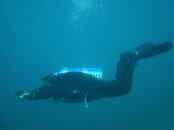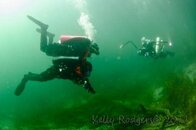Depending on your gear, you may not be able to "fix it." Gear DOES make a difference and, in your case, perhaps you have the wrong fins.I was able to get proper trim by dumping some weight (down to 2 lbs in the pool), but my feet drag. How in the world do you prevent that?
I had a student yesterday who complained of the same issue -- my proposed solution to her was to let air get into the feet of her dry suit AND perhaps, not use the same type of tank. There are many reasons why we end up in the attitude we do.
(War story -- a couple of years ago I was off Maui diving on a wall and was fighting to "stay in trim" -- and finally decided, screw it -- have fun. So, I just went pretty much vertical and drifted the wall. The gear I had wouldn't LET me be horizontal as it had been set up.)






